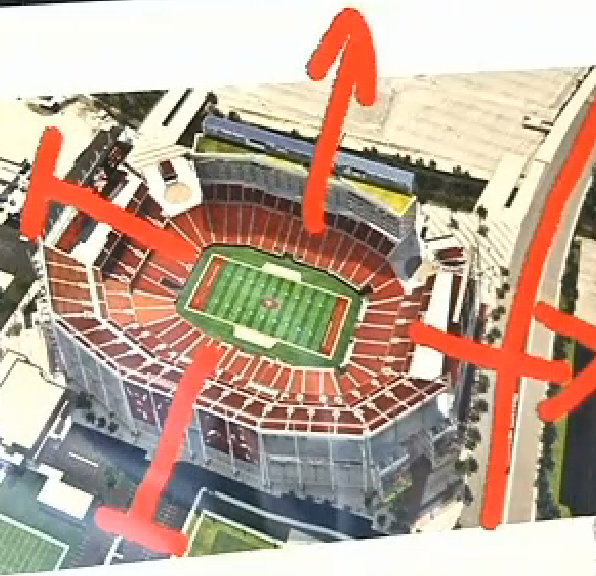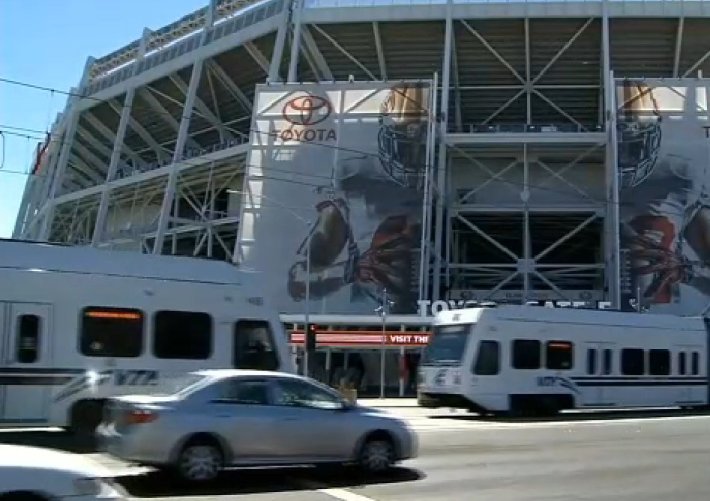Santa Clara County's Valley Transportation Authority says it does not plan to reduce light-rail service in order to move more cars at Levi's Stadium during the post-game traffic crunch.
"Transit is not the problem; transit is a solution," the agency wrote in a blog post yesterday, countering a report from the San Jose Mercury News on Monday.
As fans left the new Santa Clara stadium's first 49ers game on Sunday, the Mercury reported that drivers "were trapped in their [parking] lots up to two hours as a constant stream of pedestrians and trains blocked their paths." Jim Mercurio, the 49ers vice president for operations, told the Mercury that "his team will look at slowing down train service, perhaps to every seven or eight minutes, to let more vehicles through." Trains were run every five minutes after Sunday's game.
VTA spokesperson Colleen Valles was quoted in the article saying, "We have extra capacity," giving the impression that the agency would go along with the idea.
But apparently not. As Cyclelicious reported yesterday, Valles penned a "strong response" to clear things up in a blog post titled, "Slowing down trains will build up gridlock":
A recent assertion that light rail was impeding traffic and that the frequency of light rail service to the stadium needs to be decreased to allow more cars through may have raised the concern of some of our riders: is VTA really considering slowing down trains to benefit cars?
The short answer is no.
It bears repeating that mass transportation is the most efficient way to move people to and from large events. With trains leaving every 5 minutes and supplemental bus service to help carry people home, VTA moved a total of 9,400 passengers in 65 minutes for the first regular-season 49ers game on Sept. 14. Transit is not the problem; transit is a solution.
If we slowed down trains or decreased their frequency, we would negatively impact that solution and would provide no tangible benefit to vehicle movement.
The Mercury News article noted that VTA increased its game-day light-rail service, after transit-riding soccer fans suffered crowded, infrequent service in recent weeks:
The Valley Transportation Authority logged another win following a really rough outing during the opening stadium event on Aug. 2. Gone are the long postgame waits for light-rail trains and over-packed train cars, as the addition of an extra storage track outside the stadium, beefed-up service and a tweak to how passengers are loaded seem to have paid off.
Still, the agency's buses and trains carried 9,400 people, down 11 percent from a peak of 10,600 during the first preseason game last month. While planners had anticipated 20 percent of attendees would take transit to stadium events, only a bit more than 15 percent rode the rails or buses Sunday.
Mark Dreger, an SF resident who went to the 49ers game, reported a positive experience on VTA:
@mikesonn @StreetsblogSF VTA light rail worked great both ways yesterday. Short lines, not crowded, and moved efficiently. Even got a seat!
— Mark Dreger (@twinpeaks_sf) September 16, 2014
Making sure transit service runs smoothly seems like a smart strategy to convince fans to come without a car next time -- and VTA apparently understands that.

As to the actual cause of the bottlenecks for cars, CBS 5 reporter Len Ramirez pointed out in a report that the stadium was situated in such a way that the parking lots can only be accessed on two sides, rather than four. "That leaves only the west side and the north side, and guess what -- the north side is also where the light-rail trains run," Ramirez said.
"It’s going to take a while to work out the kinks, which makes sense," said Ratna Amin, transportation policy director for SPUR, which has offices in SF and San Jose. "In a location like where Levi’s Stadium is, it is essential that things work for cars, and it's essential that they work for transit. Any solution that discourages transit ridership to the stadium would be a step backward.”






